
11 - Phrasing and tricks
Even though some phrasings are useful for other instruments, here they are just notated in tabulature for guitar players.Now you know what notes you can play (Arpeggios and scales), but there are many ways and tricks, how you can play these notes.
A good teacher can help you here. Or you observe carefuly the fingers of your heroes in video clips on YouTube.
Typical phrasings in Gypsy Swing are...
- Octave licks- Chromatic lines
- Rhythmically played chords with syncopes
- Overtones (Flageoletts in french)
- Hammer-On and Pull-Off
- Tone doubling
- Bending
- Fast vibrato
Octave licks
Octave licks are an easy way, to give your solo some power and loudness. They sound almost like chords.The good thing about octave licks is, that you don't need to play many notes or fast, but it will sound massive.
Listen to the theme of Django's composition "Daphne", to hear what I state.
For grabbing an octave, you can use your index and ring finger or your index finger and pinkie. To avoid the ringing of unwanted strings, damp them with your middle finger. Hold it slightly on the strings A and E.
Minor Swing - Intro
Here an example from Angelo Debarre and Tchavolo Schmitt, how they play the intro of "Minor Swing" on their album "Memories of Django".
Chromatic lines
You can add chromatic notes to scales and arpeggios, or make a chromatic run over two octaves.Playing chromatic lines is kind of a "primitive" form of soloing.
But, it is hard to play them fast, tight and precise! Django was a master in this discipline! He slided ultrafast with one finger over the thin E string and picked each note perfectly!
Minor Swing - Chromatic lines
In the recording of Minor Swing from 1937, Django played chromatic lines in triplets over the E7 chord.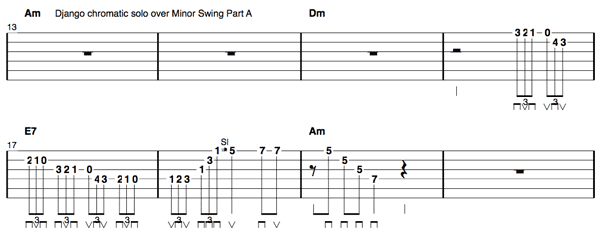
In this example, he doubled each eighth note.
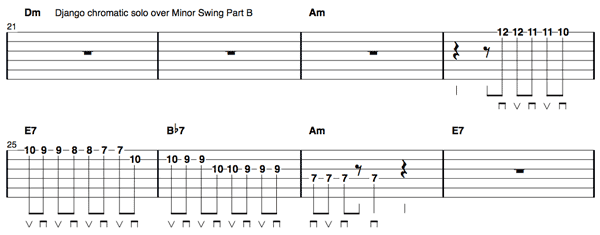
Rhythmically played chords with syncopes
Tchavolo Schmitt is a great master in this discipline! In almost every improvisation, he starts to play funky chords in the last chorus, to bring his solo to the climax.Minor Swing - Chord Solo
This example goes over the A-part of Minor Swing.To get in to the groove, play downstrokes at the downbeats and upstrokes at the upbeats.
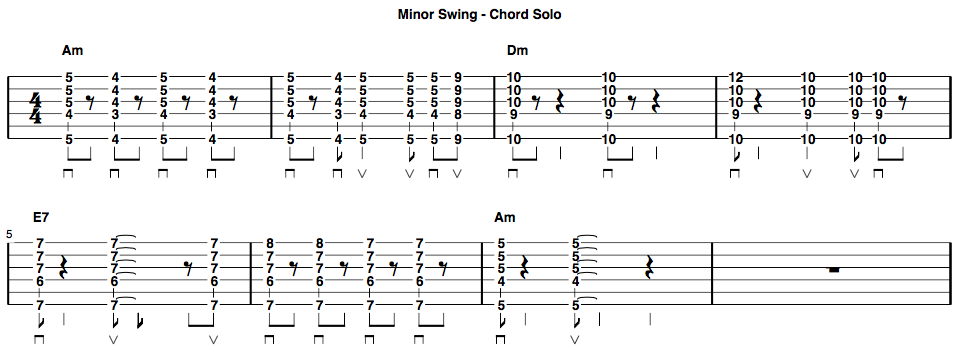 click to zoom in
click to zoom inOvertones (Flageoletts)
You can hear a beautiful example for overtones in Django's solo of "Nuages".Overtones are used often in the outro as the very last notes of a song.
There are two kind of overtones. Here I explain just the simple one.
To produce an overtone, hold your finger on any string (without pressing) exactly on the fret 5, 7 or 12. After picking the string, remove your finger immediatly. If you made it right, you will hear a glassy, singing sound.
Hammer-On und Pull-Off
Slap your finger on the string for making a hammer-on. Pull your finger downwards from the string, to make a pull-off. This technique allows you to bring in some very fast played notes without great effort.
Here an example over a full chorus of Minor Swing. Each chord change starts with a hammer-on pull-off lick.
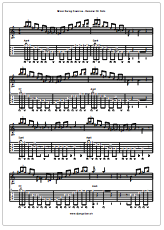
click the picture to zoom in

click the picture to zoom in
Tone doubling
When you play the same note on two strings with a fast tremolo, you will get a nice and powerful effect.You can play it over chords, which have the same notes as the empty strings E, A, D, G and B. That would be the chords G maj, C maj and D maj. It works also over G7.
Hungaria - Tone-Doubling-Tremolo
In Hungaria for example, you can play this gimmick over the bars 13-16.
Bending
A beautiful way to bring feelings into the improvisation is to bend a note a halftone higher.At lower frets, bending a string with one finger can be quite hard and painful. You better add a second finger for support.
Minor Swing - Bending Solo
Here an example, how Django bent the notes a halftone in his solo from 1947.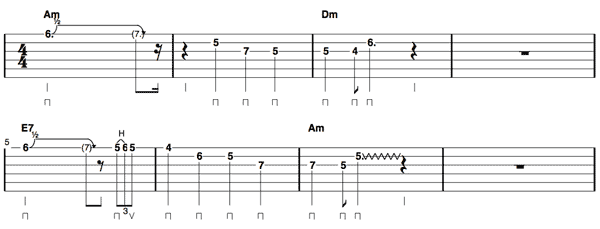
Fast vibrato
To emphasize the last note of a lick, play it with a fast vibrato.This kind of phrasing gives your improvisation the very characteristic sound of Gypsy Swing. You can't find such fast vibratos in any other music style!
Listen carefully to Django's vibratos. Also Stochelo Rosenberg, how he is playing them.



